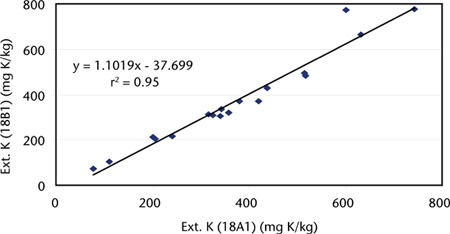
This method is a modification of the procedure developed by Kerr and von Stieglitz (1935, 1938). Soil extraction involves the equilibration for 4 h at 25°C of air-dry soil of <2 mm with 0.05 M HCl at a soil/solution ratio of 1:40. Potassium in the clarified extract is determined by ICPAES, AAS or FES.
This simple test has been used in Queensland for over 50 years (Anon 1965) to indicate the K fertility of surface soils from land use surveys and related purposes. Figure 18.1 shows the linear relationship established between this method and Method 18A1, using soils mainly from Australia. Table 18.2 provides soil fertility ratings applicable to this method.
Extracting Solution (0.05 M HCl)
Add 200 mL 10 M hydrochloric acid (HCl) to deionised water and make volume to 40 L. This extracting solution remains stable for a considerable period when stored in a clean polyethylene container. Confirm molarity in a manner similar to that given in Method 7A1; adjust to the required molarity using the formula given in Method 7A1.
Potassium Primary Standard
1 L contains 500 mg of K+.
Prepare as described in Method 18A1 but dilute to volume with 0.05 M HCl Extracting Solution.
‘Low Strength’ Potassium Working Standards
Initially prepare a 50 mg K/L solution by diluting 50 mL K Primary Standard to 500 mL with 0.05 M HCl Extracting Solution in a volumetric flask. Next dispense 0, 1.0, 2.0, 5.0, 10.0 and 15.0 mL of this Intermediate Solution into separate 100 mL volumetric flasks and make each to volume with 0.05 M HCl. These solutions contain 0, 0.5, 1.0, 2.5 …7.5 mg K+/L and for a 1:40 soil/solution ratio are equivalent to soil concentrations of 0, 20, 40, 100, 200 and 300 mg K+/kg. Store in well-sealed plastic bottles.
‘High Strength’ Potassium Working Standards
Dispense 0, 1.0, 2.0, 3.0, 4.0, 5.0 and 6.0 mL K Primary Standard into separate 100 mL volumetric flasks and make to volume with 0.05 M HCl. These solutions contain 0–30 mg K+/L and for a 1:40 soil/solution ratio are equivalent to soil concentrations of 0, 200 … 1200 mg K+/kg. Store in clean, sealed plastic bottles.
Weigh 5.0 g of air-dry soil (<2 mm) into 250 mL plastic bottles, add 200 mL 0.05 M HCl Extracting Solution and mechanically shake end-over-end for 4 h at 25°C. Centrifuge or filter (Whatman No. 42 – tested K+ free) to obtain soil extracts free of solid particles.
Analyse for K+ in the clarified extracts and appropriate Working Standards by FES, AAS, or ICPAES. Use procedures similar to those described in Method 15A1/18A1.
Report hydrochloric acid-extractable K+ (mg K+/kg) on an air-dry basis. To convert to cmolcK/kg, divide mg K+/kg by 391.
Figure 18.1. Comparisons of median values (air-dry) of soil-extractable K+ by Methods 18A1 and 18B1, obtained from inter-laboratory proficiency programs of ASPAC from 1993–1997. Grand median values were 350 and 329 mg K/kg for methods 18A1 and 18B1, respectively.
Table 18.2. General ratings from Rayment (2003) for the interpretation of both bicarbonate-extractable K+ and acid-extractable K+ (cmolcK/kg) in air-dry surface soils from northern Australia.
Rating |
Value/range |
Very low |
<0.1 |
Low |
0.1–0.2 |
Medium |
>0.2–0.5 |
High |
>0.5–1.0 |
Very high |
>1.0 |